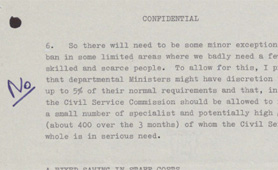I’ve had this quote scrawled on a piece of Christmas wrapping paper that I’ve been carrying around since, well Christmas. Boxing Day to be precise.
It comes from Neil MacGregor’s A History of the World in 100 Objects, chapter 19, The Mold Gold Cape. He describes how the removal of the skeleton at the dig site meant that they lost so much more potential information about the way people lived at the time. The story of the cape was only half told.
“For although the precious finds will usually survive, the context which explains them will be lost, and it’s that context of material – often financially worthless – that turns treasure into history.”
You might say that for our records it’s what turns documents from Peter and Jane into Shakespeare…
We’ve already spoken of the importance of context in managing information, but this is IMPORTANT. So let’s explore further. A few days after I was leafing through someone else’s Christmas presents, The National Archives released a set of Margaret Thatcher’s files. One of the elements that caused so much attention was her hand written notes in the margins of the papers. They bring so much more context to the documents, an insight into her thoughts and personality.

But you can’t write on a digital document. It really messes up your screen and your IT department will not be happy. So where are these hand-written notes of the digital age? How will we be able to tell our stories in the same depth for Tony Blair, Gordon Brown or David Cameron?
We now scratch our comments in layers within our digital objects when we track comments and changes. Which we then obscure in the final saved versions. We send them in emails, or SMS messages. We add them to collaborative workspaces. We spread them across a range of files and formats, many of them seemingly trivial, or made so by the random sprawl such as our email inboxes. It could be argued that the mass of digital information being created is context in some way or other, floating around a smaller mass of key data.
We have no way of understanding the importance of the ephemera we create, nor the need to keep it. No more so than those who disposed of the skeleton at the Mold dig. And history has always made do with what it has been left.
In our digital world we have the opportunity to tell so much more. And the possibilities of telling so much less than we could have.
This only increases the problems in losing historical documents and that paper records are far more historically accurate than digital records and unless all ministerial and Special Advisors papers are preserved in their entirety then you can never be sure you have the whole story. The Leverson Inquiry shows the importance of e-mails!.When paper records were created it was clear what the importance was going to be, e.g. don’t show this file (on Crichel Down) to ministers in case ministers discover that what they agreed and announced was not the scheme that was being applied to the x-degree.
Thanks David. I’m not sure I agree that paper records are more historically accurate than digital, they are subject to the same flaws and issues with their management; and digital does hold the capacity to ensure a far more accurate audit and provenance trail. The great thing about the digital information and systems we have available is that they do offer a far more detailed understanding than paper ever did. Perhaps a better (?) analogy would be to say that email and the associated social and communication media offer us a “Rosencrantz and Guildenstern are Dead” view of the events. The dilemma we face is in understanding and managing that and providing the appropriate technology to do so, if indeed we even want that level of understanding.
Mark
It could be argue that follow-up emails between recipients of the originals often contain comments, thoughts or a bit more information. If these could be stored at the same time a the document to which they refer so that the link is explicit, this may be a partial solution [though does not compensate for the originals in the text] Perhaps a hybrid system is the answer….